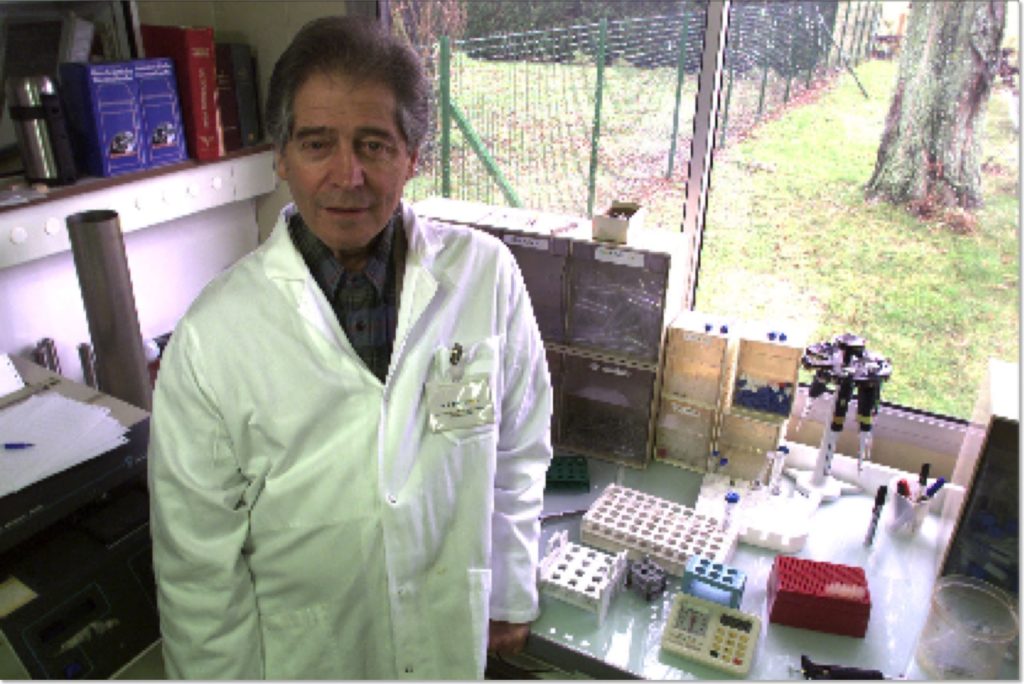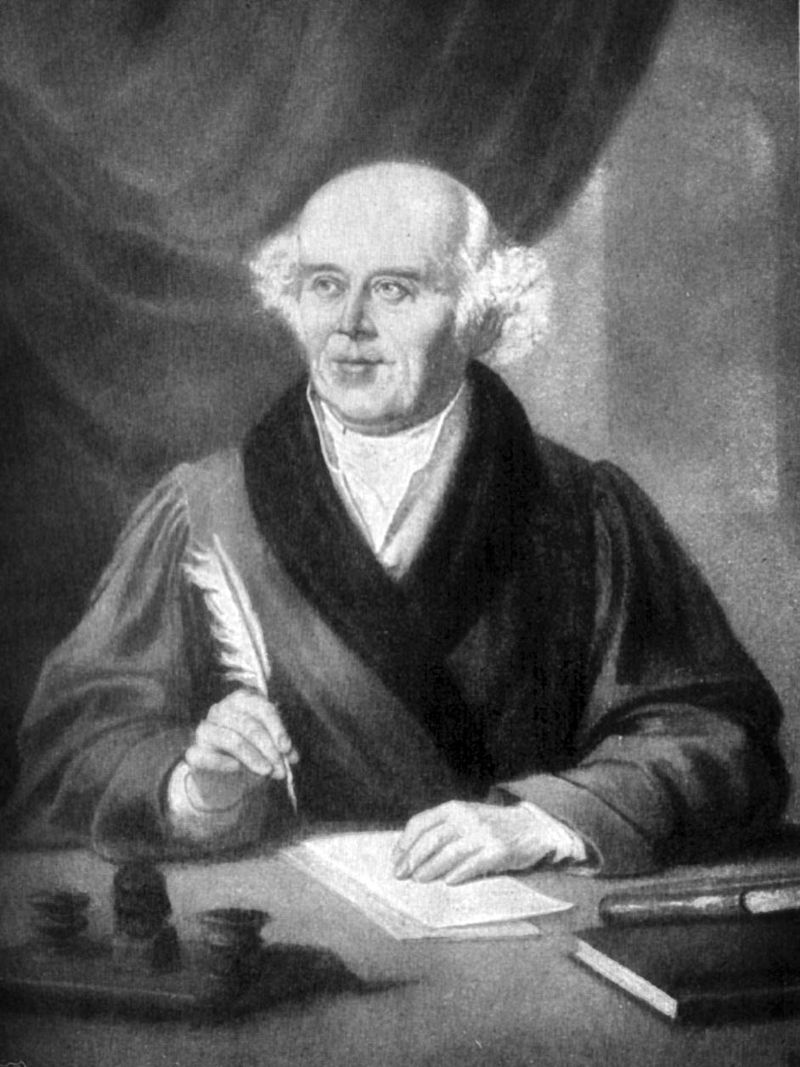Samuel Hahnemann, father of homeopathic medicine.
A paper published in the June 30, 1988 issue of the high-profile scientific journal Nature shocked the biomedical research world. Its anodyne title, “Human Basophil Degranulation Triggered by Very Dilute Antiserum Against IgE”, probably didn’t cause any non-scientists to choke on their breakfast cereal. But in the eyes of the mainstream scientific world, the article made a radical claim: Pure water, admittedly with a special history, could generate an immune reaction in a test tube. And its senior author, Jacques Benveniste, was a respected establishment scientist who headed one of France’s most important immunology research groups.
The test designed for the special water was an in vitro reaction by cells of the immune system. Those cells were basophils, which can release histamine, the mediator that produces allergic symptoms in response to allergens such as pollen or certain drugs. In one of the standard systems for studying the immune response in vitro, an antibody that recognizes structures on the surfaces of basophils triggers histamine release, through a process called degranulation. Granules containing histamine and other mediators within the basophil move to the surface of the cell and discharge their contents into the blood. The French authors of the paper in Nature were claiming that very, very dilute solutions of that antibody would do. In fact, the triggering antibody had been diluted so much that the solutions being tested contained none of it; they were just water. They proposed that because that water had been subjected to the antibody before dilution, it could still trigger degranulation even after all of the antibody was diluted out.
If that claim sounds familiar, it is essentially one of the foundational principles of homeopathy, which scientists and regular doctors consider to be a pseudoscience. The principle is, that dilution of a biological agent doesn’t necessarily prevent a response to it. On the contrary, its effectiveness may increase as its concentration dwindles, all the way to zero. But if it’s true that such dilution does not affect biological activity, conventional science is in existential trouble. Practitioners of homeopathy, needless to say, were thrilled by the results published that day.
What is homeopathy?
People often confuse homeopathy with naturopathy. Naturopathy includes an array of anti-mainstream medical practices, such as herbalism, chelation therapy, iridology, ozone therapy and reflexology. Many naturopaths oppose, or at least fail to support, vaccination. Naturopaths also practice homeopathy, which is a system of beliefs and practices that include the idea that “like cures like”; agents that induce symptoms similar to those of the disease being treated are effective cures for it. For example, Cinchona Bark induces fevers and shivering, and is an effective treatment for malaria, a disease that induces chills and fevers. (Conventional medicine says that it has this effect because it contains quinine, a biological agent with known anti-malarial properties.)
As already mentioned, another homeopathic principle is that dilution often doesn’t reduce the potency of a treatment agent. Homeopaths often dilute the curative agent to the vanishing point, literally; the solution used on the patient may contain none of the starting material. Maintenance of biological potency at zero concentration was the key conclusion of the research reported in Nature in May 1988. If the results of the Nature paper were correct, then everyone, including practitioners of conventional medicine, would have to take another look at homeopathy, and a good hard look at mainstream science.
How did such an anti-establishment paper get published in Nature?
If someone who was not part of the scientific establishment had submitted that manuscript to Nature, the editor would have politely informed them, by return mail, that it would never be published in Nature. He might suggest that they try submitting it to another (lesser) journal, a polite way of saying “go away”. But the senior author of the study, Jacques Benveniste, was held in high regard in the international scientific community, and could not be dismissed lightly.
Benveniste had made a number of research contributions, the most important being the discovery and description of a molecule called Platelet Activating Factor, PAF. PAF is involved in several defense mechanisms animals use to fight disease. These include the immune response, blood clotting, and the aggregation of defensive cells to a wound, among others. In 1972, the 37-year-old Jacques Benveniste was the first author on a research report that first identified PAF. His reputation was made, and by the 1980s he was head of one of the major French research units in immunology. Definitely a member of the establishment.
The mind of Nature’s editor, John (now the late Sir John) Maddox, trained in Physics, couldn’t accept the paper’s conclusion that a sample containing only water would produce a specific immune reaction. He was including himself when he wrote, at the end of the article, “Readers of this article may share the incredulity of the many referees who have commented on several versions of it . . . ” Yet he didn’t want to be seen as blocking unconventional thinking, even if it seemed patently wrong. What to do? Maddox hit on a unique solution: the paper would be published, but the authors would have to have their work confirmed by others, something that regularly happens when a major discovery is made. But also, and this was highly irregular, the experiments in Benveniste’s lab would have to be performed before a panel of visiting experts. Benveniste agreed to both conditions, and the paper was published.
The memory of water
When the paper from Benveniste’s group was published, it was greeted by cheers and jeers. Homeopathic practitioners felt that, finally, a member of the scientific establishment agreed with them that infinitely dilute solutions could have a biological effect. But the biomedical establishment groaned as it witnessed the prestigious platform, Nature, being used to dispense what it called nonsense. But as Nature’s editor Maddox pointed out, if the results were correct, everyone would have to take a sober look at the claims of homeopathy. Or maybe he was so sure the results were wrong that the process of proving it would unmask and bring down homeopathy. If so, he was both right (about the unmasking) and wrong (about the bringing down).
The data in the Benveniste paper were unambiguous; infinitely dilute samples that contained no trace of the original agent could set off the degranulation of basophils. Degranulation of basophil cells in the laboratory is parallel to the event that starts an allergic reaction. It goes like this: an antibody of a certain class (IgE) that recognizes and tightly binds the allergen to which a person is hypersensitive (which may be pollen, or a drug) coats basophils in the blood. When the allergen shows up, it binds to the antibody and causes it to trigger the cells to degranulate, releasing a number of mediators, including histamine. The released mediators flood the system, causing sniffles and sneezing and other symptoms. Under some circumstances, a sudden and life-threatening anaphylactic reaction happens.
The authors of the Nature paper claimed that samples that had originally contained an agent that activated basophils, but was now diluted to the point that it no longer contained anything but water, stimulated degranulation. Pure water that had never seen the agent did not. How could this be? Homeopathy had an answer: the molecules of water in the sample had been influenced by the original agent to form “memory” structures around it, and those structures passed that memory on to other water molecules upon further dilution. Homeopathic theory holds that such effects can actually become more potent as the solution is diluted. This has the advantage, unfailingly mentioned by its practitioners, of obviating any chance of harm. Even if the original agent was toxic, it’s long gone. It is but a memory. And now, homeopathic theory had a champion in the form of a new believer who was part of the establishment. He had confirmed their theory with conventional science.
But that kind of thinking was simply unacceptable to conventional scientists. All chemical-based science, including biology, is dependent on the law of mass action, for example, which means that two molecules will combine and react with each other more avidly, the higher their concentration. There is simply no place in conventional, mainstream, science for the “memory of water”, a term that the popular press came up with to describe the convention-overturning, mainstream-defying results that now appeared in one of the world’s most prestigious scientific publications, thanks to the deal that its editor had made with Jacques Benveniste.
Testing the memory of water
When the Benveniste paper was published, both it and Nature’s editor in chief were subjected to coruscating criticism. But part of the deal was that the results had to be confirmed in other labs, and had to be obtained under scrutiny by a review team organized by Maddox. The first part of that deal, confirmation by other labs, never really happened. The people Benveniste had named as being involved in that process never published any results on the subject (indeed, curiously, they were not particularly prominent in the related field). But Maddox soon had his investigative team assembled, and in June 1988 they showed up on Benveniste’s doorstep to oversee the work.
To say that Benveniste was shocked by the makeup of the group of three investigators is putting it mildly. Maddox was one of the three, and that made some sense; he was a trained scientist, albeit from the field of Physics. The second member was the American scientist Walter Stewart, who was an avid fraud-hunter. But the third was James Randi, who was not a scientist at all; he was a stage magician, also known as “The Amazing Randi”, who had a second career unmasking paranormal, occult and supernatural claims. A few years later, he would gain international fame by revealing how an Israel stage magician named Uri Geller was bending spoons without apparent effort. According to Randi, scientists could often be fooled, because they tend to assume things are what they seem. He, on the other hand, was always looking for the distraction hiding the magic trick.
Benveniste, not burdened by false modesty, later spoke of himself on the BBC show “Catalyst” (2003), (link here) in the following terms: “I was considered as, well in French we have a word which says nobelise…nobelisable, which means we can have a Nobel Prize because I started from scratch the whole field of research. I was the head of a very large team, had a lot of money and so I was a very successful person.” And the science of the nobelisable immunologist was going to be answerable to a stage magician? Mon dieu!
Randi, for his part, found Benveniste to be a charming, continental gentleman with a great personality. He was a celebrity in France, with plenty of charisma. His personality, intelligence, and even his good looks helped him command admiration and respect.

The Fall
Under close scrutiny by the Amazing Randi and his fellow sceptics, the researchers in the Benveniste lab easily reproduced their results showing a biological effect of water. But Maddox saw that the people doing the test (measuring degranulation of basophils) could potentially see which samples were the result of dilution of the original biological agent, and which were simply water, the controls. So the lab technicians preparing the diluted samples were put into a room not visible to anyone (newspapers were taped over the windows). The visitors then encoded the samples, and Stewart and Randi, using a stepladder, taped the code to the ceiling. The code would only be revealed after the results of the degranulation test were recorded the next day. Benveniste was not amused: he later remarked, “Sticking an envelope to the ceiling was utterly ridiculous. There is no way you can associate that with science.”
The next day, the laboratory group was ready to celebrate. It was party-time; cracked crab legs and magnums of champagne packed in ice were readied, and a regal dinner was promised. The press was in attendance. Randi performed tricks to amuse the folks as they waited for the results. Jacques Benveniste felt sure he would be vindicated. But that didn’t happen. The result was a complete failure. The highly diluted samples produced no effects. Proper double-blinding of the experimenters had produced a negative outcome. At that moment, Benveniste’s reputation began a steep dive. As he stated on the BBC show, his phone stopped ringing. Soon he lost his position, his lab, and his reputation. The Amazing Randi put up a 1 million dollar reward for anyone who could prove the dilution effect, or any other paranormal event. Nobody, then or later, ever won the prize, although some tried.
The disproof of the phenomenon was published in Nature (2). Scientists could breath again.
What was Benveniste thinking?
From his words and actions, Jacques Benveniste clearly believed in the result predicted by the “memory of water” (that was a term invented by the media, not him). He stated later that a lab worker had approached him with the puzzling result that the agent being tested for degranulation worked at huge dilution. Initially sceptical, he claimed, he nevertheless came to believe the result. Were unprincipled lab personnel playing him? Randi’s comment that scientists can be fooled comes to mind.
What was even sadder than the spectacle of the unmasking was Benveniste’s continuing faith in the phenomenon. He maintained this position without wavering (he died in 2004). His subsequent career got really strange. From his much-reduced laboratory circumstances, he said he had evidence that molecules communicated electronically and that he could capture that signal digitally, and even transmit it over the telephone (later, the Internet). He started a company, DigiBio, to capitalize on this “discovery”. The US Defence Advanced Research Agency (DARPA) organized an attempt to reproduce the phenomenon, without success.
But despite the consensus of the scientific and medical mainstream that there is no evidence that homeopathy works, movie stars, famous athletes, public figures, Prince Charles, and ordinary folks still believe in it and subject themselves to it. Two hundred million around the world, according to a homeopathy website. Also, there are still people trying to get the results originally reported by Benveniste in 1988. Zombies never die.
Go To Contents
Sources
- Davenas et al., Nature 333:816 (1988).
- Maddox, J., J. Randi, and W. W. Stewart, Nature 334:287 (1988). “‘High-dilution’ experiments a delusion”




